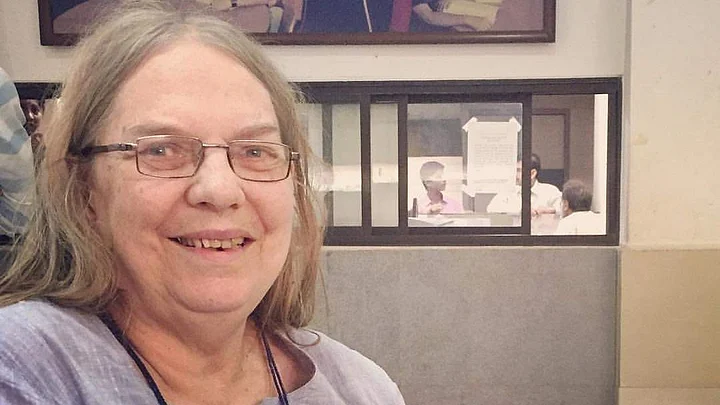United States-born scholar and activist Gail Omvedt died on Wednesday, 25 August, at the age of 81 in her village Kasegaon, in the Sangli district of Maharashtra. I had gone to meet Gail in Kasegaon in 2017; I was accompanying a friend who was working on a documentary on her. Unfortunately, neither Gail nor her husband Bharat Patankar was at home that day.
Gail was already at an advanced age at that time and was showing signs of frailty. I knew this was my only chance to see her in person, and felt bad that I had missed it. However, all the people we met in Kasegaon that day spoke very fondly of Gail and her work.
Even though I never got to meet her, I encountered Gail multiple times through her writings and discussions on her with others interested in Maharashtra’s Phule-Ambedkarite movement. When a young friend of mine heard of her death today morning, she messaged, “Feeling like I’ve lost someone very close to me,” an emotion shared by many because no matter what their age, people who knew her work, did not just admire her but also felt kinship towards her.
From Minneapolis to Kasegaon
How did this white woman, who was born in Minneapolis, United States, end up in an interior village of Maharashtra? Gail’s PhD thesis was on the non-Brahmin movement in Maharashtra, inspired by Jotirao Phule and his Satyashodhak Samaj. As a sociologist, Gail learned Marathi and did extensive fieldwork in parts of the state. However, she did not remain just a scholar working in a university set-up.
With her husband Patankar – whom Gail had met in her movement work in Maharashtra, had fallen in love with, and gotten married to – she became an integral part of Maharashtra’s working class struggles, ranging from anti-caste movement to agricultural issues, Adivasi movement, environment to feminist movement.
Gail truly epitomised the figure of an activist-scholar. Her work on Phule was especially important because Phule and his Satyashodhak Samaj had faced complete neglect by Anglophone scholars till the 1970s. However, her book Cultural Revolt in a Colonial Society: The Non-Brahman Movement in Western India showed the revolutionary work done by Phule, his organisation, and the non-Brahmin movement that followed and reached its peak in the 1910s and 1920s just before the emergence of BR Ambedkar.
Ambedkar personally knew and had worked with many non-Brahmin leaders, including Shahu Maharaj, Keshavrao Jedhe, and Dinakarrao Javalkar. In a way, Ambedkar built on and carried forward the legacy of Phule and the Satyashodhak movement in his unique and charismatic style.
Scholarly Contribution
Gail picked up on the themes that were central to Ambedkar’s struggle, such as Buddhism. In her book Buddhism in India: Challenging Brahmanism and Caste, she presented a broad sweep of Buddhism’s history in India over two-and-a-half millennia, however, keeping the question of caste at its very heart. She also wrote a short biography of Ambedkar titled Ambedkar: Towards an Enlightened India and an introduction to caste titled Understanding Caste: From Buddha to Ambedkar and Beyond.
In her book Seeking Begumpura: The Social Vision of Anticaste Intellectuals, Gail sought to introduce and popularise figures that are important to the anti-caste movements across India, from bhakti saint Ravidas to Tamil radical EV Ramasamy Periyar. With Patankar, she also took up translation projects such as Phule's Marathi book Shetakaryacha Asud and the 17th-century Varkari saint Tukaram’s abhangas. Here, one can see Gail’s impulse to merge scholarly work with activism.
In Maharashtra’s Phule-Ambedkarite, Bahujan public sphere, the trio of foreign women—Eleanor Zelliot, Gail Omvedt, and Rosalind O’hanlon—all of whom learned Marathi and extensively worked on the Marathi region, command a special regard. However, among these, only Gail settled in Maharashtra, acquired an Indian citizenship, and became a full-time activist.
Omvedt's Legacy
Gail’s work was important in shaping my own understanding of caste in Maharashtra. Her books, along with Zelliot and O’hanlon’s works, give us a comprehensive view of the Phule-Ambedkarite movement from the 19th century to the present. Gail also showed how one can make useful connections with other anti-caste movements in the country and her Marxist, materialist approach to caste enriched our thinking of this hierarchical, discriminatory system, and pointed towards a possible way out.
Gail’s death feels like a personal loss and leaves a tremendous hole in Maharashtra’s bilingual public sphere. Gail was unique in the sense that she was an outsider and insider at the same time, flawlessly worked in both English and Marathi, and was simultaneously a part of multiple social movements in Maharashtra while managing to command equal respect in all of them. A figure that can be a connecting dot across such a wide spectrum is hard to come by. May Gail’s legacy live on.
